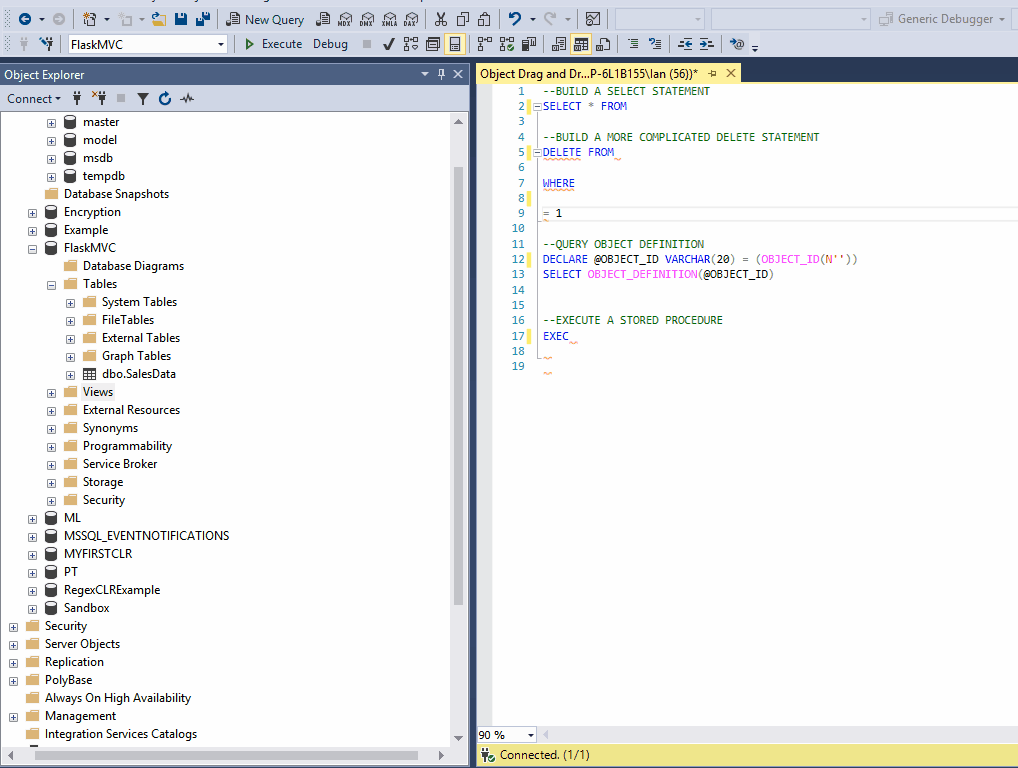

- #Sql studio manager table multiple delete how to
- #Sql studio manager table multiple delete update
- #Sql studio manager table multiple delete code
- #Sql studio manager table multiple delete windows
#Sql studio manager table multiple delete code
CREATE SECURITY INTEGRATION (Snowflake OAuth) spDELETEMULTIROW CODE XML ,ERRFLAG CHAR (1) '0' OUTPUT AS SET NOCOUNT ON SET TRANSACTION ISOLATION LEVEL READ UNCOMMITTED DELETE tbSampleTest WHERE CODE IN ( SELECT Item.value ('.', 'VARCHAR (20)') FROM CODE.

#Sql studio manager table multiple delete update
Delete Cascade And Update In Sql Server Foreign. Import Data From Multiple Excel Files Into Sql Server Tables Using An Ssis Package. Top 10 Sql Server Management Studio Ssms Tips And Tricks Sqlmatters. Cte Sql Deletes Considerations When Deleting Data With Common Table Expressions In Server.
#Sql studio manager table multiple delete windows
Wednesday, Janu3:42 PM 0 Sign in to vote Thanks - my confusion was that the 'Summary' window does not come to the front when you click on the tree view to the side (I had some query windows open). The idea behind this (for me anyway) is purely from a developer’s perspective. You can select multiple objects in the summary page and then click the delete key to delete them. Now if you go back into SSMS and right-click on a table, you will see that the Context Menu options have changed to Select and Edit All Rows. Wednesday, Janu3:42 PM Steven Twitchell - MSFT 1,810 Points 0 Sign in to vote Thanks - my confusion was that the 'Summary' window does not come to the front when you click on the tree view to the side (I had some query windows open). For the second multiple-table syntax, only matching rows from the tables listed in the FROM clause (before the USING clause) are deleted. You can obviously change the values for each as you wish (for example 2000 for select top 2000 rows), but if you would like to select and edit all the rows, change these values to 0 Selecting all Rows in SSMS You can select multiple objects in the summary page and then click the delete key to delete them. Use the Column Removal Wizard tool in SQL Server Management Studio. From the options on the right-hand side, look for the fields Value for Edit Top Rows Command and This will delete the column from the table, leaving the data in its original location. Click on Tools in the menu, and then Options.
#Sql studio manager table multiple delete how to
The good news is that you can change this default selection to whatever you like by following these steps: You can modify the script to create SQL table functions or to include additional SQL for managing or testing the table function. Here are two approaches to delete records from a table using SQL: (1) Delete records based on specified conditions: DELETE FROM tablename WHERE condition (2) Delete all the records in a given table: DELETE FROM tablename In the next section, you’ll see how to apply the above approaches using a practical example. I’m going to show you exactly how you can use SQL Server Management Studio, edit all rows and get your whole table back allowing you to modify the data? SQL Server Select all RowsĪs mentioned earlier, the standard way of selecting rows is to select only the top 1000 rows. So how do you tell SQL Server, edit all rows, please? If you need to edit more data than 200 rows, then the SQL Server Management Studio, Edit rows command will not suffice. Query Stack Overflow With T-SQL – Give Your Queries A WorkoutĬhoosing Select Top 1000 Rows does not tell SQL Server Management Studio, edit all rows, please.Prevent Accidental Table Data Deletion In SQL Server Management Studio.Automate Standard Comment Blocks For New SQL Queries.Easily Generate Table Change Scripts In SQL Server Management Studio.Script Table Data In SQL Server Management Studio.Looking for something else? Try these links instead: If you use SQL Server Management Studio often, you will have noticed that from the context menu that is displayed when right-clicking on a table, there are two options (among the others) namely Select Top 1000 Rows and Edit Top 200 Rows.


 0 kommentar(er)
0 kommentar(er)
